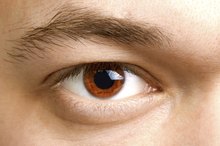Causes of Sinus Pain Under the Cheekbone
Sinus pain under the cheekbone usually indicates an abnormality of the largest of the nasal sinuses, called the maxillary sinus. That sinus is located directly under the cheekbone and covers the area from just above the upper teeth to just below the eye socket, according to the book "Head and Neck Surgery—Otolaryngology" by Byron Bailey 1. The ethmoid sinuses are located deeper and closer to the nose, but can also cause pain under the cheekbone. Pain in that area can also be due to migraine headaches, tooth infections and facial trauma.
If you are experiencing serious medical symptoms, seek emergency treatment immediately.
Acute Sinusitis
Acute sinusitis, also known as acute rhinosinusitis, is a sinus infection that lasts less than two months 2. Infections that cause inflammation in the sinuses can cause sinus pain under the cheekbone, according to MayoClinic.com 23. The pain may be due to either inflammation or pressure in the sinuses due to fluid buildup during an acute infection.
Chronic Sinusitis
What Is Total Opacification of the Maxillary Sinus?
Learn More
Chronic sinusitis refers to a sinus infection that lasts more than two months or keeps coming back 3. According to MayoClinic.com, chronic sinusitis causes swelling around the openings of the sinuses, which causes mucus to build up inside the sinuses 23. The constant pressure from that mucus buildup leads to a dull pain under the cheekbones. Other symptoms may include nasal congestion, decreased sense of smell, watery eyes and swelling around the face and eyes.
Nasal Polyp
Nasal polyps are pus-filled polyps that grow inside the sinuses. The polyps often result from chronic sinusitis 3. According to the book "Pathologic Basis of Disease" by Ramzi Cotran, the polyps do not cause any symptoms at first, but when they get larger they start to push on bone and block off the sinuses 4. Once they get to that point, they cause pain similar to chronic sinusitis 3. Ear nose and throat specialists often have to perform surgery to get rid of the polyps.
Tumor
What Are the Causes of Intense Sinus Pain Without Congestion?
Learn More
Tumors of the nose and sinuses, whether benign or malignant, can cause sinus pain under the cheekbones. The reasons why are similar to those for nasal polyps. Beside pain, sinus tumors often cause other symptoms such as bleeding, nasal blockage, decreased smell and vision changes.
- Tumors of the nose and sinuses, whether benign or malignant, can cause sinus pain under the cheekbones.
- Beside pain, sinus tumors often cause other symptoms such as bleeding, nasal blockage, decreased smell and vision changes.
Related Articles
References
- "Head and Neck Surgery—Otolaryngology"; Byron Bailey; 2006
- MayoClinic.com: Acute Sinusitis
- MayoClinic.com: Chronic Sinusitis
- "Pathologic Basis of Disease"; Ramzi Cotran; 1999
- American Academy of Allergy Asthma & Immunology. Aspirin-Exacerbated Respiratory Disease (AERD).
- Hamilos DL. Chronic Rhinosinusitis (Beyond the Basics). UpToDate.
- Hamilos DL. Clinical Manifestations, Pathophysiology, and Diagnosis of Chronic Rhinosinusitis. UpToDate.
- Sedaghat AR. Chronic Rhinosinusitis. Am Fam Physician. 2017;96(8):500-506.
- ENTHealth. American Academy of Otolaryngology–Head and Neck Surgery Foundation (AAO-HNSF). Fungal Sinusitis. Updated January 2019.
- Cleveland Clinic. Chronic Sinusitis: Prevention. Updated February 10, 2018.
- American Academy of Allergy Asthma & Immunology. Aspirin-Exacerbated Respiratory Disease (AERD).
- Lin YH, Chang TS, Yao YC, Li YC. Increased Risk of Chronic Sinusitis in Adults With Gastroesophgeal Reflux Disease: A Nationwide Population-Based Cohort Study. Medicine (Baltimore). 2015;94(39):e1642. doi:10.1097/MD.0000000000001642
- Reh DD, Higgins TS, Smith TL. Impact of tobacco smoke on chronic rhinosinusitis: a review of the literature. Int Forum Allergy Rhinol. 2012;2(5):362-9. doi:10.1002/alr.21054
- Sinusitis. The Nemours Foundation.
- Hamilos DL. Chronic Rhinosinusitis (Beyond the Basics).
- Hamilos DL. Clinical Manifestations, Pathophysiology, and Diagnosis of Chronic Rhinosinusitis.
- Reh DD, Higgins TS, Smith TL. Impact of Tobacco Smoke on Chronic Rhinosinusitis – A Review of the Literature. International Forum of Allergy & Rhinology. 2012;2(5):362-369. doi:10.1002/alr.21054.
- Sinusitis. American Academy of Otolaryngology—Head and Neck Surgery.
Writer Bio
Joe Sharg holds a Master of Public Health degree from the Harvard School of Public Health. His first published article was in the "Journal of Neuro-Oncology" in 1999. Since then, his work has been featured in numerous medical journals, on CNN and in "The New York Times" and "USA Today."








